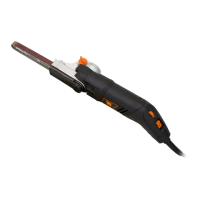5
SPECIFIC RULES FOR THE SANDER
3. Securing the Workpiece
Never hold the workpiece in your hand or across your legs. Small workpieces must be adequately secured so that
the rotating belt doesn’t pick them up during the forward motion of the sander. Unstable support causes the belt
to bind, resulting in a loss of control and possible injury.
4. Checking the Powercord
Make sure that the power cord is prevented from coming into contact with the machine or getting caught up on
other objects preventing completion of the sanding pass.
5. Holding the Sander
Keep handles and hands dry, clean and free from oil and grease. Hold the power tool by the insulated gripping
surfaces only in case the belt contacts its own cord. Cutting a “live” wire may make exposed metal parts of the tool
“live” and could give the operator an electric shock.
6. Sand on Dry Surfaces Only
This machine is to be used for dry sanding only. Do not attempt to use for wet sanding operations, as fatal electric
shock may occur.
7. Starting the Sander
Always start the sander before the sanding belt is in contact with the workpiece. Let the sander reach full speed
before using the tool. Do not start the machine whilst it is in contact with the workpiece.
8. Sanding the Workpiece
CAUTION: when the machine contacts the workpiece it will have a tendency to grab and pull forward. Resist the
forward motion and keep the belt sander moving at an even pace. Never pull the tool backwards over the work-
piece. Sand in the direction of the grain whenever possible. Remove the sanding dust between each grade of sand-
ing sheet. Never leave the machine unattended while it is still running.
9. Setting Down the Sander
Wait for the belt to stop before setting the tool down. An exposed rotating belt may engage the surface, leading to
possible loss of control and serious injury. Always lay the sander on its side to prevent accidents if the machine is
inadvertently started.
10. Unplug Your Sander
Ensure that the sander is disconnected from the main supply before servicing, lubricating, making adjustments,
changing accessories, or replacing sanding belts. Accidental start-ups may occur if the tool is plugged in during an
accessory change. Before plugging the tool back in, check that the trigger is OFF.
11. Replacing the Sanding Belt
Replace the sanding belt as soon as it becomes worn or torn. Torn sanding belts can cause deep scratches that are
difficult to remove. Ensure that the sanding belt is the correct size for the machine. After changing a sanding belt,
rotate the belt to make sure it doesn’t hit any part of the tool.
12. Cleaning your Sander
Clean and maintain your tool periodically. When cleaning a tool, be careful not to disassemble any portion of the
tool. Internal wires may be misplaced or pinched and safety guard return springs may be improperly mounted.
Certain cleaning agents such as gasoline, carbon tetrachloride, ammonia, etc. may damage plastic parts.

